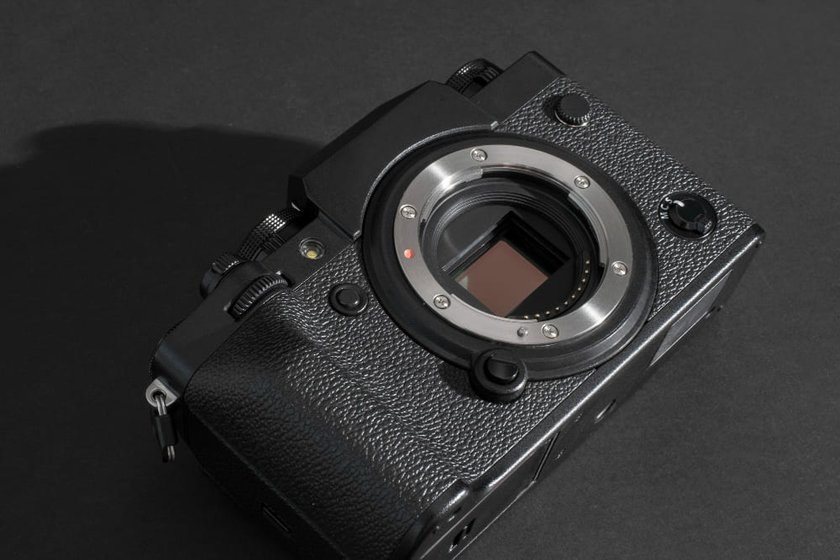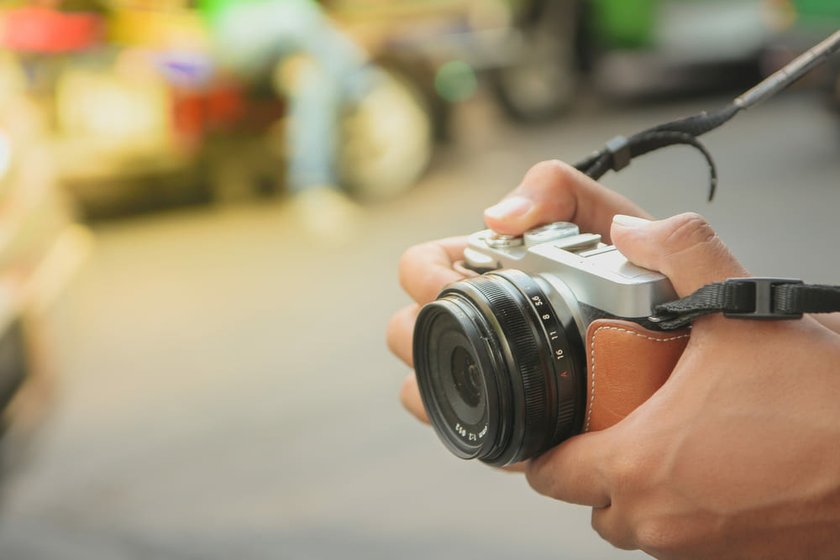The outcome of the photographer's efforts often depends on the proper camera choice. Photographers use two main types of gadgets nowadays: DSLRs and mirrorless cameras.
In this context, what are mirrorless cameras? These camera systems dispense with other cameras' traditional swinging mirror mechanisms. Instead, light enters through the lens directly onto the image sensor, giving you a live preview of your shot right on the screen.
In this article, we explore what mirrorless cameras are. But here, we will define mirrorless cameras and observe their positive and negative characteristics.
Mirrorless Camera Explained: Pros And Cons
 What does mirrorless camera mean? It's a digital camera that distinguishes itself from traditional digital single-lens reflex (DSLR) cameras by omitting the reflex mirror. In DSLRs, this mirror reflects light into the optical viewfinder, granting you a view through the device's lens. When you snap a photo, the mirror flips up, allowing light to reach the image sensor and capture the image.
What does mirrorless camera mean? It's a digital camera that distinguishes itself from traditional digital single-lens reflex (DSLR) cameras by omitting the reflex mirror. In DSLRs, this mirror reflects light into the optical viewfinder, granting you a view through the device's lens. When you snap a photo, the mirror flips up, allowing light to reach the image sensor and capture the image.
Advanced yet easy-to-use photo editor
Get Luminar Neo NowConversely, mirrorless cameras do away with the mirror mechanism commonly found in DSLRs. Instead of relying on optical viewfinders, they use digital displays such as electronic viewfinders (EVFs) or LCD screens, delivering an immediate real-time preview of the scene. Once you press the shutter button, these cameras capture images directly on the image sensor. Mirrorless cameras are celebrated for their compact form, lighter weight, and versatility, making them a favored option for photographers prioritizing portability and ease of use. Furthermore, they provide the flexibility of interchangeable lenses and boast advanced features akin to DSLRs.
Pros of Mirrorless Cameras
 Let's delve into the unique features of mirrorless cameras. They keep their sensors continually exposed to light, granting an immediate digital preview through electronic viewfinders (EVFs) or LCD screens. This distinctive trait ensures a seamless photography experience, where the displayed image closely resembles the final photograph, simplifying composition and adjustments.
Let's delve into the unique features of mirrorless cameras. They keep their sensors continually exposed to light, granting an immediate digital preview through electronic viewfinders (EVFs) or LCD screens. This distinctive trait ensures a seamless photography experience, where the displayed image closely resembles the final photograph, simplifying composition and adjustments.
Electronic viewfinders (EVFs) have undergone remarkable enhancements as time passes. They now offer clear, high-resolution displays that faithfully replicate optical viewfinders while delivering real-time updates on exposure, white balance, and other settings.
Mirrorless cameras' compact and lightweight design positions them as ideal companions for travel and street photography. Their versatility shines through the availability of various interchangeable lenses, allowing adaptability in different photographic scenarios.
Notably, the absence of mirror mechanisms grants mirrorless cameras the ability to capture images silently. It proves invaluable in noise-sensitive settings like wildlife photography, weddings, or street photography, where disrupting the moment is not an option. Many mirrorless cameras feature advanced autofocus systems that offer rapid and precise focusing, often outperforming DSLRs, particularly in scenarios involving fast-moving subjects.
Cons of Mirrorless Cameras
 They are known for their battery consumption. The constant use of the EVF or LCD screen can drain the battery quickly, so if you plan to use it for long-time photo sessions, an extra battery should always be by your side.
They are known for their battery consumption. The constant use of the EVF or LCD screen can drain the battery quickly, so if you plan to use it for long-time photo sessions, an extra battery should always be by your side.
While the adaptability of lenses is a significant advantage, some mirrorless systems may have a limited selection of native lenses.
Although EVFs have improved significantly, there may still be a slight lag in some models, affecting fast-paced action shots.
High-end devices usually cost a lot, and the price of lenses can add up quickly.
Nevertheless, carefully choosing the mirrorless camera model can mitigate many of these drawbacks. So, carefully consider and focus on lens selection options and electronic viewfinder capabilities. Additionally, there are budget-friendly options readily available in the current market. What other aspects should you take into account when purchasing a mirrorless camera? Let's explore them further.
Exclusive Tools of Endless Possibilities in One AI Editor
EXPLORE NOW!Choosing The Best Camera
 Here are some crucial factors to consider when selecting the perfect mirrorless camera:
Here are some crucial factors to consider when selecting the perfect mirrorless camera:
1. Sensor Size
Sensor size is pivotal in selecting the right device for your needs. A larger sensor offers superior performance in low-light environments and yields higher image quality. Common sensor sizes for mirrorless cameras encompass Micro Four Thirds, APS-C, and Full Frame options. You should weigh your budget and your photography genres to identify the most suitable choice.
2. Performance and Features
Different models cater to different photography styles. Consider what features are required for your needs, such as fast autofocus, image stabilization, weather-sealing, and video capabilities. Consider the video quality and features if you are a vlogger or videographer.
3. Size and Weight
These devices are known for being small and light. If portability is a priority, choose a model that suits the on-the-go style. However, if you have certain specific requirements that might demand a larger gadget body, be prepared to compromise on size for functionality.
4. Brand and Ecosystem
Consider the brand and its ecosystem. Some brands offer a wider selection of lenses and accessories and strong customer support. Research the available lenses, firmware updates, and the brand's reputation.
5. Ergonomics and Handling
A device that feels comfortable in your hands and has intuitive controls can significantly impact the shooting experience. Visit a store to get a feel for different models.
6. Reviews and Recommendations
Do your research by reading reviews and seeking recommendations from fellow photographers. Online photography communities and forums can provide valuable insights into various mirrorless cameras' performance and user experiences.
Bottom Line
Comprehending what mirrorless cameras are, their pros and cons, and the key factors in their selection allows you to chart your photography journey effectively.
Remember that despite mirrorless cameras' numerous advantages, addressing potential drawbacks through thoughtful selection and adaptation to your requirements is possible. Whether embarking on a photography journey or contemplating a gear upgrade, choosing the appropriate model will enable you to capture remarkable images with precision and flair.




